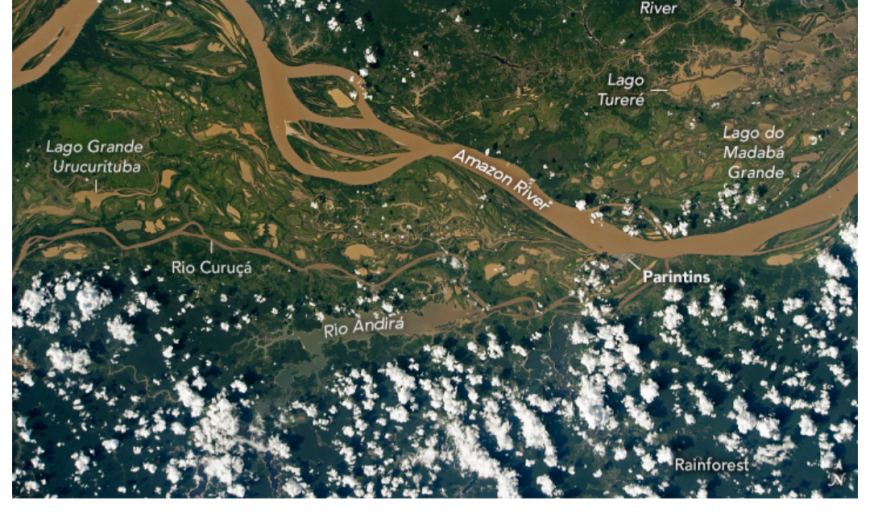December 23, 2020.
An astronaut aboard the International Space Station took this photograph of the lower Amazon River in Brazil. The 190-kilometer (120-mile) span of river pictured here is in the vicinity of Parintins, a port city on the Amazon.
The river is the largest on Earth and allows seagoing ships to reach Parintins even though it is 800 kilometers (500 miles) inland from the Atlantic Ocean. Seagoing ships can progress 3,600 kilometers (2,200 miles) up the Amazon River—more than halfway across the South American continent—to the port of Iquitos in Peru. The color of the river water in this image results from a heavy sediment load. The sediment erodes from the Andes Mountains located to the west and is carried generally eastward toward the ocean (from left to right in this image).
Annual flooding covers much of the wide floodplain that flanks the river. During these flooding events, the main channel of the Amazon delivers muddy water to adjacent lakes, such as Lago Grande Urucurituba, Lago do Madabá Grande, and Lago Tureré. Astronaut photographs of the same area, such as this sunglint image, show that the lakes expand to cover areas three or four times larger during peak flooding.
The floodplain even affects local cloud patterns. Dark forested surfaces (top and bottom margins of the image) are associated with small cumulus clouds, whereas the floodplain is cloud-free.
The main reason for this pattern is likely that the waterlogged floodplain is slightly cooler than the surrounding soils and trees of the rainforest. Cooler surfaces are known to suppress cloud formation under some meteorological conditions and is a common phenomenon over rivers.
Smaller rivers—such as the Andirá (lower left) and Nhamundá (top right) contain dark, nearly sediment-free water. While part of the larger Amazon basin, these rivers drain the forests (not the Andes Mountains) and carry almost no sediment.
Astronaut photograph ISS064-E-14990 was acquired on December 23, 2020, with a Nikon D5 digital camera using a focal length of 110 millimeters. It is provided by the ISS Crew Earth Observations Facility and the Earth Science and Remote Sensing Unit, Johnson Space Center. The image was taken by a member of the Expedition 64 crew.
The image has been cropped and enhanced to improve contrast, and lens artifacts have been removed. The International Space Station Program supports the laboratory as part of the ISS National Lab to help astronauts take pictures of Earth that will be of the greatest value to scientists and the public, and to make those images freely available on the Internet.
Additional images taken by astronauts and cosmonauts can be viewed at the NASA/JSC Gateway to Astronaut Photography of Earth. Caption by Justin Wilkinson, Texas State University, JETS Contract at NASA-JSC.
Source, NASA.

